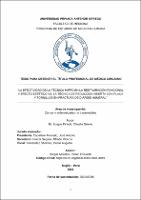Mostrar el registro sencillo del ítem
La efectividad de la técnica MIPPO en la restauración funcional y efecto estético vs. La técnica de reducción abierta con placa y tornillos en fractura de diáfisis humeral
| dc.contributor.advisor | Vargas Morales, Renán Estuardo | |
| dc.contributor.author | Burgos Pineda, Claudia Selene | |
| dc.creator | Burgos Pineda, Claudia Selene | |
| dc.date.accessioned | 2022-08-04T03:16:38Z | |
| dc.date.available | 2022-08-04T03:16:38Z | |
| dc.date.issued | 2022 | |
| dc.identifier.uri | https://hdl.handle.net/20.500.12759/9242 | |
| dc.description.abstract | Valorar la efectividad de la técnica MIPPO frente a la técnica RAFI en la restauración funcional y efecto estético de los pacientes postoperados de fractura de diáfisis humeral. Materiales y Métodos: Es un estudio de tipo analítico, cohorte retrospectiva, con 45 pacientes post-operados por fractura de diáfisis humeral en el Hospital HVLE durante el período de Agosto 2014 a Agosto 2019, divididos en 15 pacientes operados con la técnica MIPPO y 30 operados con RAFI. Se recopiló los datos a partir de historias clínicas, radiografías control y se aplicó el score QuickDASH presencial o virtual para obtener la restauración funcional, además se valoró el tamaño de la cicatriz postoperatoria para obtener el efecto estético de ambas técnicas. Se analizaron estadísticamente los resultados con la prueba de T student para las variables principales y con el Test Chi-cuadrado para las variables secundarias. Resultados: La edad promedio de los pacientes fue de 48,8 años, la mayoría de sexo femenino. Además hallamos menos complicaciones postquirúrgicas, tiempo de consolidación más corto, menor dolor postoperatorio y mayor rango de movilidad con la técnica MIPPO, pero no significativo estadísticamente. Con respecto a la duración de la cirugía, ambas técnicas tuvieron un tiempo operatorio similar. (p=0,831). No se encontraron diferencias significativas entre los dos grupos con respecto a la restauración funcional (p=0,075), a pesar de un puntaje menor obtenido con MIPPO. Asimismo, se encontró una diferencia estadísticamente significativa en el efecto estético de los pacientes postMIPPO (p= <0,001) que con RAFI. Conclusión: En este estudio, la técnica MIPPO fue más efectiva que RAFI en el efecto estético, pero no fue significativa al evaluar la restauración funcional. | es_PE |
| dc.description.abstract | To evaluate the effectiveness of the MIPPO technique over the ORIF technique in functional restoration and aesthetic effect of postoperative patients with humeral shaft fractures. Materials and Method: This is an analytical study, retrospective cohort, with 45 postoperative patients for humeral shaft fractures in the HVLE Hospital during the period from August 2014 to August 2019, divided into 15 patients managed with the MIPPO technique and 30 patients managed with ORIF. The data were collected from clinical records, control radiographs, and the QuickDASH score was applied virtually or face-to-face to obtain functional restoration, also the size of the postoperative scar was assessed to get the aesthetic effect of both techniques.The results were statistically analyzed with the T student test for the main variables and with the Chi square test for the secondary variables. Results: The average age of the patients was 48.8 years, mostly female. We also found fewer complications, shorter union time, less postoperative pain, and a greater range of motion with the MIPO technique, but not statistically significant. Regarding the period of surgery, both techniques had a similar operation time. (p=0,831). No significant differences were found between the two groups concerning functional restoration (p=0,075), despite a lower score obtained with MIPPO. Likewise, a statistically significant difference in the aesthetic effect of postMIPPO patients (p=<0,001) was found compared with ORIF. Conclusions: In this study, the MIPPO technique was more effective than ORIF in the aesthetic effect but it wasn’t significant when evaluating functional restoration. | en_US |
| dc.description.uri | Tesis | es_PE |
| dc.format | application/pdf | es_PE |
| dc.language.iso | spa | es_PE |
| dc.publisher | Universidad Privada Antenor Orrego | es_PE |
| dc.relation.ispartofseries | T_MED_3240 | |
| dc.rights | info:eu-repo/semantics/openAccess | es_PE |
| dc.rights.uri | https://creativecommons.org/licenses/by/4.0/ | es_PE |
| dc.source | Universidad Privada Antenor Orrego | es_PE |
| dc.source | Repositorio Institucional - UPAO | es_PE |
| dc.subject | MIPO | es_PE |
| dc.subject | RAFI | es_PE |
| dc.title | La efectividad de la técnica MIPPO en la restauración funcional y efecto estético vs. La técnica de reducción abierta con placa y tornillos en fractura de diáfisis humeral | es_PE |
| dc.type | info:eu-repo/semantics/bachelorThesis | es_PE |
| thesis.degree.level | Título Profesional | es_PE |
| thesis.degree.grantor | Universidad Privada Antenor Orrego. Facultad de Medicina Humana | es_PE |
| thesis.degree.name | Médico Cirujano | es_PE |
| thesis.degree.discipline | Medicina Humana | es_PE |
| dc.subject.ocde | https://purl.org/pe-repo/ocde/ford#3.02.27 | es_PE |
| renati.advisor.orcid | https://orcid.org/0000-0003-3948-4949 | es_PE |
| renati.author.dni | 75748923 | |
| renati.advisor.dni | 18139849 | |
| renati.type | https://purl.org/pe-repo/renati/type#tesis | es_PE |
| renati.level | https://purl.org/pe-repo/renati/level#tituloProfesional | es_PE |
| renati.discipline | 912016 | es_PE |
| renati.juror | Caballero Alvarado, José Antonio | |
| renati.juror | Huerta Segura, Alfredo Ricardo | |
| renati.juror | Fernández Sánchez, César Augusto | |
| dc.publisher.country | PE | es_PE |
Ficheros en el ítem
Este ítem aparece en la(s) siguiente(s) colección(es)
-
Medicina Humana [2969]


